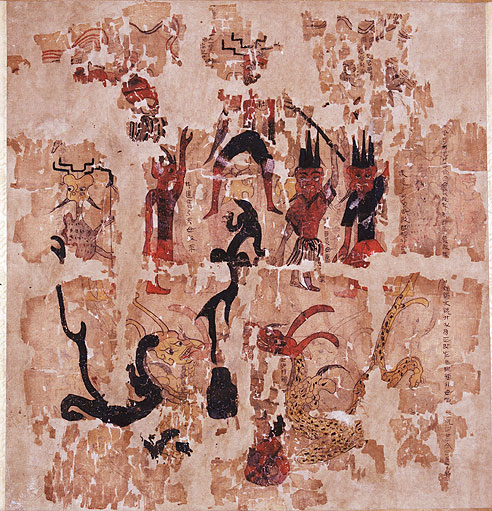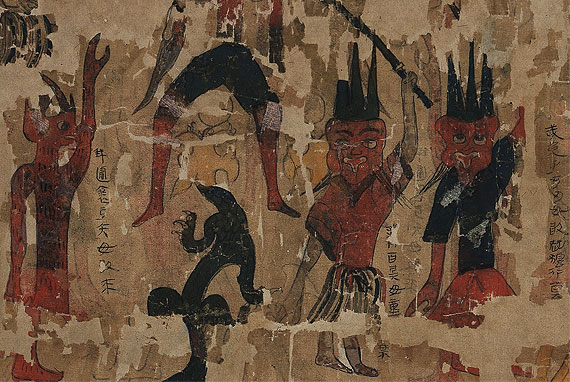Taiyi on the Move

Taiyi on the Move
Western Han Dynasty (206BC—25AD)
Ink and colors on silk;
Dimensions: L: 43.5cm; W: 45cm
Unearthed from Han Tomb No.3 at Mawangdui, Changsha City, Hunan Province in 1973
The painting on silk known as Taiyi on the Move is a sorcerer’s rendering related to the deity Taiyi. In the upper center of the drawing is a strange god with antlers, who might be the god Taiyi, based on a vertical, two-line inscription on his left side, or the god of land according to the Chinese character “社(She)” written under his armpit. Below him are two other deities, one on each side. Directly under him is a blue dragon with a yellow head, on either side of which is another dragon. The painting depicts deities on the move and is suffused with a mythological atmosphere. There is mixed response in the academic world about how to interpret this painting. Some scholoars believe that the painting was used by the tomb occupant to pray to Taiyi for the victory before he led his army on expeditions in his lifetime. Historical documents show that the word “Taiyi” first appeared in the mid-Warring States period, in books such as the Elegies of Chu (Chuci). By the Han Dynasty, Taiyi had become the supreme deity. The excavation of this painting proves that worship of Taiyi had become popular after the mid-Warring States period.

深入探索
The Legends of Taiyi
Taiyi in this painting refers to the heavenly god, the head of all gods. Elegies of Chu (Chuci) mentioned Taiyi as the almighty god of heaven, stationed in the center and followed by other gods. Many other classical works record the existence of Taiyi and all regard him as the original life-generating god. Worshipping Taiyi was popular in the land of Chu.
According to the Elegies of Chu (Chuci), with Taiyi’s divine power, he is in charge of rain and wind, floods and droughts, weapons and armors, food and dearth, diseases and plagues, etc., which are closely interrelated to the people’s life and happiness. Moreover, he could even generate life and determine the ways of Heaven and Man. Therefore, by the Han Dynasty, Taiyi had become the most respected heavenly god. By the time Emperor Wu Di of the Han dynasty ascending the throne, sacrificial activities have been regularly held as a statutory festival in every fifteenth day of the first lunar month to worship Taiyi God, which is regarded as the prelude of Lantern Festival celebrated by our Chinese people. Ancient ancestors chose early spring to commemorate Taiyi, the head of all gods, in the hope of praying for favorable weathers, good harvest and flourishing population of the coming year.



